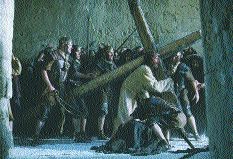Tough guy

In the 1927 silent version of The King of Kings, directed by Cecil B. DeMille, Christ is first seen from the point of view of a blind man regaining his sight. It is a masterful touch that adds grandeur to the story. Over the decades, scores of films have been made about Jesus of Nazareth. Many of these productions dripped with Hollywood glitz, while others tackled serious issues of faith. All of them understood that no story about Jesus is complete without addressing the holy trilogy of events: the mystery of his life, the agony of his death and the miracle of his resurrection.
Now comes Mel Gibson’s The Passion of the Christ, which is the Kill Bill of Jesus movies. This version doesn’t bother with Christ’s role as prophet, teacher or healer (except in a few perfunctory flashbacks). It is concerned only with the final 12 hours of Christ’s life—from his arrest in the Garden of Gethsemane to his death on the cross.
Much has been made of the extreme violence in the film, starting with the beating Christ takes upon his arrest; the hypergraphic scourging that tears the flesh from his body; the tortuous trek to Calvary; and the endless crucifixion, which makes the controversial crucifixion scene in Martin Scorsese’s Last Temptation of Christ look like a fourth-grade play.
The problem with The Passion isn’t the amount of violence, however (even if the Bible never suggests anything so brutal), so much as the fact that there’s little in the film except violence. The flashbacks give us an occasional respite, but they almost feel like breaks between rounds while the Roman guards get fresh whips.
The charge of fueling anti-Semitism has dogged this film from the start. I’d say it’s a close call. Though Gibson doesn’t exactly blame the Jews alone for Christ’s death, he seems to be having an awfully good time making the high priests of the temple look wide-eyed and cartoonish as they smack their lips at the bloodletting. (Caiaphas’s blustery conduct—stomping around and screaming—actually reminded me of corrupt union boss Johnny Friendly [Lee J. Cobb] in On the Waterfront.)
Gibson claims he stuck close to scripture when crafting the script with co-screenwriter Benedict Fitzgerald (Wise Blood), and by picking and choosing among the four Evangelists he has fashioned a version that suits his needs. (The dialogue is delivered in Aramaic and Latin, with English subtitles.) But beyond the “one from column A, one from column B” approach to the structure, he has found plenty of room for incidents that are pure inventions. They range from an absurd flashback to Jesus’ days as a carpenter, in which he all but tells Mary that he has invented mission-style furniture (“See? High tables, high chairs,” he says), to Mary mopping up the blood after the scourging, to a raven plucking out the eyes of the Bad Thief.
Then there is the portrayal of Pontius Pilate, who comes across as a Roman Dr. Phil. Though Pilate has been undergoing a cinematic reinvention over the years, in part due to the possibilities suggested by his “What is truth?” query (check out David Bowie’s wily interpretation in Last Temptation), he has seldom before been so clearly portrayed as a man who really wants to save Jesus from the cross, and would have if not for that loud, nasty (and heavily Jewish) rabble. History informs us that Pilate was a brutal prelate who would crucify anyone at the drop of a hat. Here he seems more concerned about hurting his wife’s feelings (she’s against Christ’s execution, another exaggeration of scripture) than about stemming the simmering revolt in Jerusalem.
The Passion doesn’t inspire. It’s like viewing an uneven boxing match in which we are forced to watch the underdog, pinned against the ropes, get beaten to within an inch of his life. We just want to turn away.
This brutality leads to an odd shot of Christ after the resurrection that suggests an angry man with a terrible hangover who is going to take it out on someone.
There are moving moments in the film, such as the eerie depiction of Satan (borrowed freely from Ingmar Bergman and David Lynch), and the frantic scenes showing Judas’s death (he is hounded by guilt until he hangs himself with a piece of rope he finds wrapped around the neck of a rotting cow).
In fact, The Passion works best when Christ is not onscreen. That’s because the Christ in this movie doesn’t represent anything Christlike, such as love or peace or forgiveness. Instead, he is a victim with the guts to stand up after a beating. That approach may work for Gibson’s other loud and gory films, from Mad Max to Braveheart to The Patriot. But to reduce Jesus Christ to a tough dude who can take a licking and keep on ticking is not exactly a feat that calls for hosannas.





